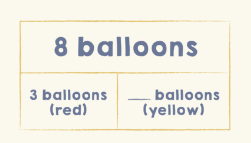July 9, 2025
“If I have 7 cookies and eat 3, how many are left?”
This is typical of the types of problems we use to introduce subtraction. And to be fair, it works. They provide context and students seem to get it. We call it “take away” and move on.
Here’s the problem: that version of subtraction doesn’t scale. And when it’s the only version we teach, it creates major misconceptions later.
The Limits of “Take Away”
When we define subtraction as “take away,” we send the message, without meaning to, that subtraction:
- Only works when you start with a bigger number
- Always results in something smaller
- Is about physically removing things from a set
And once that idea gets locked in? Everything that doesn’t fit that mold starts to feel confusing or wrong. (Just like when we teach kids that equal means ‘the same as’.)
Think about it:
- What happens when students see 3 – 7?
- Or have to solve for a missing part in __ + 5 = 9?
- Or try to compare two different amounts, like “How many more cars does Nadia have than Jamal?”
In those moments, “take away” doesn’t help. In fact, it gets in the way.
Subtraction Is About Relationships
Subtraction isn’t just one thing. It shows up in different ways depending on the situation. When word problems are thrown into the mix, that’s where Structures of Equality becomes essential.
Instead of teaching subtraction as a fixed action (like taking something away), we teach students to look for the structure of the problem.
Let’s see how this plays out with two of the structures.
1. Parts Equal Total (PET)
Use this when the math main idea describes a total being decomposed into parts or parts composing a total.
Example: Ms. Felder has 8 balloons. Three are red. How many are yellow?
Subtraction can be used to solve this, but no one’s taking anything away. The problem is about separating a total into parts.
“Part–whole subtraction problems don’t involve removing anything. Instead… you separate the whole group into two parts and find the size of each part.” —Subtraction: More Than Just Taking Away (Well-Trained Mind)
We model it like this:

The total is known. One part is known. The other part is missing. When a story describe that relationship, we can use subtraction to solve.
2. Compare
Use this when the math main idea describes comparing two distinct quantities, or sets.
Example: Nadia has 8 cars. Jamal has 5. How many more does Nadia have?
Again, nothing is removed. No one is “taking away” cars from anyone. The concept here is difference.
“Comparison subtraction is the most challenging interpretation… you subtract to find out how much bigger (or how much smaller) one set is compared to another.”
—Subtraction: More Than Just Taking Away (Well-Trained Mind)
We model it like this:
The question isn’t about what’s left. It’s about what’s extra.
What Happens When We Shift the Framing
When we teach subtraction through structure instead of shortcuts, students begin to:
- Make sense of subtraction beyond whole numbers
- Understand why 3 – 7 doesn’t break the rules; it’s just moves us into negative numbers, which are still part of the number system
- See subtraction as a tool for comparison, not just removal
- Build confidence when working with equations like __ + 5 = 9
- Use visuals (like Structures of Equality models or number lines) to think, not just solve
Most importantly, they stop guessing and start reasoning.
So What Do We Say Instead?
Here’s what helps:
✅ “What part is missing?”
✅ “What’s the difference between these two?”
✅ “What’s the relationship between these two quantities?”
✅ “Let’s draw a model to show what we know.”
And here’s what to leave behind:
🚫 “Take away”
🚫 “You can’t subtract a bigger number from a smaller one”
🚫 “When you subtract, you end up with a smaller number.
Final Thought
When subtraction is taught as “take away,” we’re only giving students one piece of the puzzle. But when we teach it as a way to make meaning, find what’s missing, or compare quantities, we give them the whole picture.
Subtraction isn’t about removing. It’s about relationships.
Let’s teach it that way.